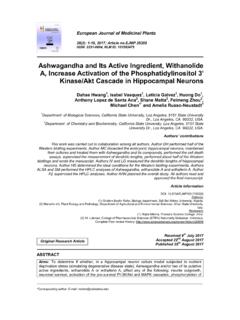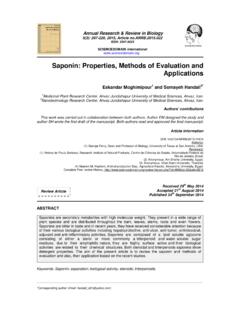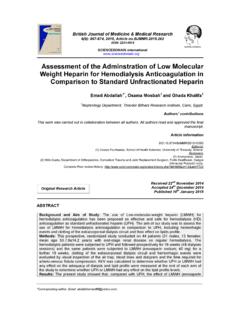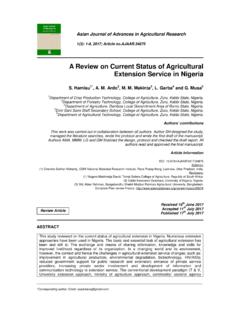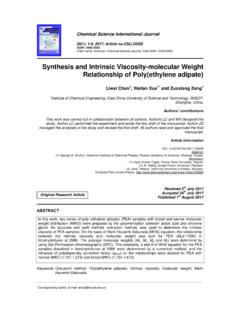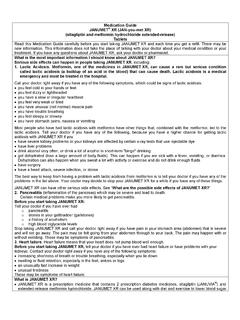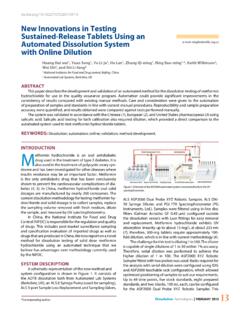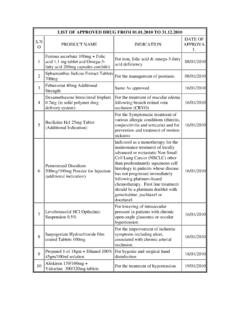Transcription of Formulation and Evaluation of Sustained Release …
1 _____ *Corresponding author: Email: British Journal of Pharmaceutical Research 1(2): 29-45, 2011 SCIENCEDOMAIN international Formulation and Evaluation of Sustained Release Matrix Tablets of metformin hydrochloride Using pH Dependent and pH Independent Methacrylate Polymers Kamlesh J. Wadher1*, Rajendra B. Kakde2 and Milind J. Umekar1 1 Department of Pharmaceutical Technology, Smt. Kishoritai Bhoyar College of Pharmacy, Kamptee, Nagpur - 441002, India 2 Department of Pharmaceutical Sciences, Nagpur University, Amravati Road, Nagpur - 440033, India. Received 24th February 2011 Accepted 28th March 2011 Online Ready 8th April 2011 ABSTRACT metformin hydrochloride is recommended globally as first line therapy due to its favorable profile on morbidity and mortality associated with type-2 diabetes mellitus.
2 However, limitations of multiple dosing and risk of triggering gastrointestinal symptoms make its dose optimization difficult. extended - Release metformin matrix tablets were prepared by direct compression of drug and different pH-dependent (Eudragit L-100 and S-100) and pH-independent (Eudragit RLPO and RSPO) polymer combinations. The influence of varying the polymer/polymer (w/w) ratio was evaluated. Among the different examined polymer blends, matrix tablets based on S-100/RLPO and S-100/RSPO mixtures gave the more Sustained Release pattern. The excipients used in this study did not alter physicochemical properties of the drug, as tested by Fourier transform Infrared Spectroscopy and the thermal analysis using differential scanning calorimetry.
3 All the batches were evaluated for thickness, weight variation, hardness, and drug content uniformity. The in vitro drug dissolution study was carried out using USP 22 apparatus II, paddle method and the Release mechanisms were explored. Mean dissolution time is used to characterize drug Release rate from a dosage form and indicates the drug Release retarding efficiency of polymer. Kinetic modeling of in vitro dissolution profiles revealed the drug Release mechanism ranges from diffusion controlled to anomalous type. Fitting the data to Korsmeyer equation indicated that diffusion along with erosion could be the mechanism of drug Release .
4 Research Article British Journal of Pharmaceutical Research, 1(2): 29-45, 2011 30 Keywords: metformin hydrochloride , extended Release matrix tablet, pH-independent polymers, pH-dependent polymers, Release kinetics; 1. INTRODUCTION Sustained Release (SR) drug delivery systems are developed to modulate the Release of drug, in order to achieve specific clinical objectives that cannot be attained with conventional dosage forms. Possible therapeutic benefits of a properly designed SR dosage form include low cost, simple processing, improved efficacy, reduced adverse events, flexibility in terms of the range of Release profiles attainable, increased convenience and patient compliance (Qiu and Zhang, 2000; Colombo et al.)
5 , 2000). Incorporation of drug in the matrix of hydrophilic and hydrophobic polymers have been successfully employed in the development of Sustained Release delivery systems to provide the desired Release profile (Qiu and Zhang, 2000). In recent years, pH-dependent drug delivery systems are considered suitable for designing Sustained -drug delivery system (Ashford et al., 1993; Risbud et al., 2000; Palmieri, 2000; Gupta et al., 2000). Amongst the available matrix forming polymers, methacrylic resins (Eudragit ) appear particularly attractive due to high chemical stability, compactability and variability in physicochemical characteristics (Rodriguez et al.
6 , 1993). Several experimental evidences revealed the Release retarding ability of ammonio methacrylate (Eudragit RL and RS) or methacrylic acid copolymers (Eudragit L and S) in solid dosage forms (Kidokoro et al., 2001; Zhu et al., 2000; Palmieri, 2000; Bruce, 2005). Due to the variable pH values observed in the gastrointestinal tract (GIT), the conventional controlled Release matrices of ionizable drugs with pH-dependent solubility may give rise to intra- and inter-individual variability in bioavailability (Yamada et al., 1990; Kohri et al., 1992; Vashi et al., 1988). Incorporation of polymers with pH dependent solubility into controlled Release matrix tablets seems to be an obvious approach that provides the desired Release over an extended period of time.
7 Hence, appropriate combinations of a pH-dependent polymer with a pH-independent one were suitable for adequately sustaining and controlling the Release and assured more reproducible drug Release behavior. metformin is an oral anti-hyperglycemic agent, shows incomplete absorption from the gastrointestinal tract and the absolute bioavailability is 50 60 % with relatively short plasma half-life of - h (Dunn et al., 1995; Defang et al., 2005). Oral absorption of metformin is confined to the upper part of the intestine, , the duodenum, jejunum and, to a lesser extent, ileum (Vidon et al., 1988) Therefore, the low bioavailability can be ascribed to a comparatively high pre-systemic clearance, due to a lack of correspondence between the time of transit of the drug delivery system, or the free drug, across the upper part of the GI tract and the time required for complete drug absorption.
8 metformin controlled Release may be by preparing formulations able to initiate Release in the stomach and complete it in the jejunum, thus realizing a correspondence between time required for complete Release and time of transit of delivery system across the upper part of the gastrointestinal (GI) tract, where drug absorption occurs and where are located sites of metformin glucose-lowering action that contribute to the overall pharmacodynamic effect (Stepensky et al., 2001). British Journal of Pharmaceutical Research, 1(2): 29-45, 2011 31 An obstacle to more successful use of metformin therapy is the high incidence of concomitant gastrointestinal symptoms, such as abdominal discomfort, nausea, and diarrhea that especially occurs during the initial weeks of treatment.
9 Side effects and the need for administration two or three times per day when larger doses are required can decrease patient compliance. A Sustained - Release (SR) Formulation that would maintain plasma levels of the drug for 10 to 16 hours might be sufficient for once-daily dosing of metformin . SR products are needed for metformin to prolong its duration of action and to improve patient compliance (Dunn et al., 1995). Therefore, the aim of the present work was to evaluate the suitability of different methacryilic resins to prepare direct compression MF matrix tablets able to assure prolonged and well reproducible drug Release profiles.
10 In particular, different types of Eudragit , RLPO and RSPO, insoluble but dispersible in water, and L100, S100, with pH-dependent solubility, were used, separately or in different (w/w) combinations, to prepare tablet. 2. MATERIALS AND METHODS MATERIALS metformin HCl was obtained from Universal Medicament Nagpur, India. Microcrystalline cellulose (MCC, Avicel pH 101) was purchased from S. D. Fine Chem. Labs. (Mumbai,India), Eudragit RSPO , Eudragit RLPO, Eudragit S-100 and Eudragit L-100 were obtained as gift samples from Degussa India Ltd. (Mumbai,India). All other ingredients used throughout the study were of analytical grades and were used as received.
